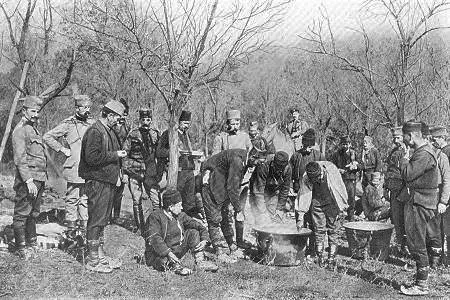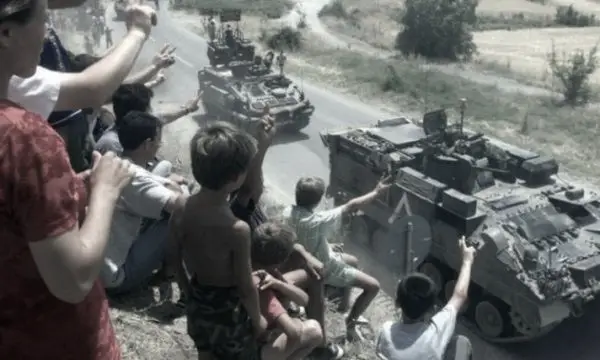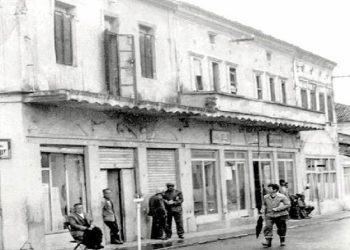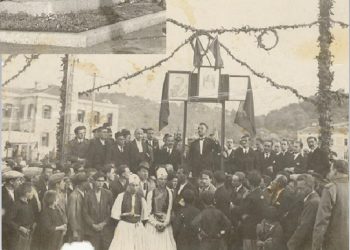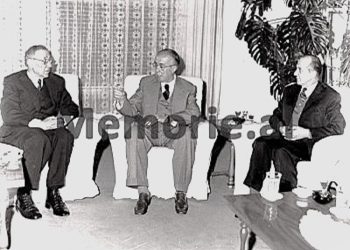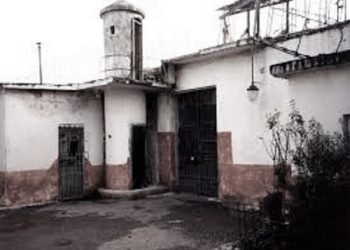From Bashkim Trenova
Part twenty one
MYTH-MYSTICISM, VICTIMOMANIA, RACISM AND SERBONOSTALGIA
ALBANIANS ACCORDING TO THE SERBS
(THE EASTERN CRISIS AND THE BALKAN WARS)
Memorie.al / “Serbs are descended from the Slavs, a large number of tribes who gave life to the Slavic peoples. Knowledge about the origins of the history of the Slavs is modest and not so clear. Their name appears for the first time in the 6th century AD, when Byzantine writers start talking about the Slavs….”! (Dushan Bataković, Milan St. Protic, Nikola Samardžić, Aleksandër Fotic. History of the Serbian People. L’Age d’Homme. Lausanne. 2005. Pg. 3.)
Continues from last issue
We’ve conquered it many times already (1912, 1918, 1944, 1989, 1999), but we just haven’t known what to do with it. In the 20th century, Belgrade tried all violent methods: gradual displacement, mass deportations, military administration, and colonization. But, because of such a policy, Kosovo Serbs have always suffered. As a rule, every wave of violence exerted by Belgrade has been accompanied by a worsening of the situation and the expulsion of Kosovo Serbs. Among the most popular myths, the “Kosovo myth” easily wins the “Golden Branch, A Study in Magic and Religion” award (1).
1 – Damian Pavlica – Kosovski mit je srpska shame, sin, genocide, laz, obmana i prevara. (The Serbian myth about Kosovo, a self-deception, fraud, lie and shameful genocide.) – Drini July 25, 2020 and Floripress Agency. December 17, 2021.
****
Daniela Jovanovic – Assistant at Collège O’SullivanUQAM/ University of Quebec in Montréal:
One of these wounds, “archived in the collective memory” of the Serbian people, is the battle of the Thrush Field of 1389 (or the battle of Kosovo Field, kos means thrush in Serbian). Raised to the rank of a national myth for Serbs starting from the second half of the 19th century, this event marks the defeat of Christian troops against the Turks and becomes the starting point of a new era of Ottoman occupation, which will last for another 500 years. .
Ten years later, on exactly the same date, the patriarch of the Serbian Orthodox Church, Monsignor Pavle, would hold a memorial mass, (service for the dead), for Prince Lazar, who fell heroically on the battlefield in 1389, next to the Christian troops. (Which regrouped Serbs, Bosniaks, but also Catholic Albanians).
This symbolic battle has remained etched in the memory of the Slavic peoples and has inspired a large number of Serbian folk songs and epic poems. Chroniclers have described the heroics of the twelve knights who, under the orders of Miloš Obilič, entered the Turkish camp to kill Sultan Murat I. Prince Kralevic Marko, as well as the Jugović brothers, who remained on the battlefield; also belong to this line of heroes glorified by tradition. “According to legend, Prince Lazar was visited by an angel on the eve of the battle.
The angel put him before the choice: to win the battle or to win the kingdom of Heaven, to win the kingdom of this world, or the heavenly kingdom… In his Christian choice, according to the tradition that circulates from the Church, Prince Lazar engaged all the Serbian people. By sacrificing themselves for the defense of Christianity, the Serbs would thus accept their dimension of a heavenly people”.
(Jean-Arnault Dérens, Laurent Geslin, Understanding the Balkans. History, societies, perspectives, Paris, Non Lieu, 2007. Pg. 25) (1)
1 – Daniela Jovanovic. Université du Québec à Montréal. Mémoires blessées des balkans. La paix aux frontières de l’ethnicité en ex-Yugoslavie. Mémoire prêtente par Daniella Jovanovic août 2008. (University of Quebec in Montreal. Wounded memories of the Balkans. Peace at the borders of ethnicity in the former Yugoslavia. August 2008). Page 107.
The myth of the battle would turn into a Serbian territorial claim only from the middle of the 19th century, during the rise of modern nationalism, after Serbia gained its autonomy in 1830. After a long “parenthesis” represented by Ottoman rule, the new Serbian state thus tries to establish, in its medieval cradle of Kosovo, the center of gravity of the field of its political and national action.
Since the 1850s the Serbian principality, autonomous after a number of uprisings in 1804, led by Karagjorgjevic in the region of Šumadija, sought to expand and find its old territories. Its prospects for expansion in the North and West are blocked by the veto of Vienna, by the Habsburg Empire.
Thus the minister Ilia Garashanin (dubbed “Serbian Bismarck” by David MacKenzie), through a new strategic orientation defined in his famous Proclamation (Načertanie), turns towards the south, with the idea of regaining “Old Serbia” (Kosovo). From here, Kosovo becomes a primary goal for the politics of Belgrade, which, in order to justify its territorial claims, will rely on the literary, mystical and religious tradition related to Kosovo.
The Balkan Wars of 1912-1913 ended by annexing Kosovo to Serbia, and the Serbian Orthodox Patriarchate, restored in l920, will find the opportunity to raise the region to the rank of “sacred myth of the nation”. Presented as a symbol of resistance and preservation of the Serbian heritage, Kosovo is still today ideologically overloaded as a cornerstone, which embodies the battles and sacrifices against the Ottoman yoke, secularization, Albanian “demographic pressure”…(1)
1 – Daniela Jovanovic. Université du Québec à Montréal.Mémoires blessées des balkans. La paix aux frontières de l’ethnicité en ex-Yugoslavie. Mémoire prêtente par Daniella Jovanovic août 2008.
(University of Quebec in Montreal. Wounded memories of the Balkans. Peace at the borders of ethnicity in the former Yugoslavia. August 2008). Pages 109-110.
—
In 1878, the creation of the Albanian League of Prizren marks the first open manifestation of contemporary Albanian nationalism, which asks the Empire to create an autonomous Albanian vilayet (administrative unit divided into sanxhaka), which would unite the four vilayets – of Vučiterni, Shkodra , Ioannina and Manastir. The simultaneous affirmation of two nationalisms, Albanian and Serbian, led to the outbreak of the first inter-ethnic violence in Kosovo, after a confrontation in Sanxhak e Nis (southern Serbia), from where 50,000 Albanians were deported to Kosovo in 1877-1878.
Kosovo, perceived in a certain way as the “land of heroes”, occupies a mythological place in the national imagination of the Serbs. It occupies the same defining genealogical place among the Albanians, who see it as the “land of the ancestors”. (2)
****
Dejan Dimitrijevic – professor of anthropology – Lumière University
Lyon 2:
The myth of Kosovo has indeed been a pillar of Serbian nationalism and was instrumentalized in the second half of the 1980s. It cannot be ignored that it was established as a central element of identity by Slobodan Milosevic, while such a thing is not done since the nineteenth century (S. Cerovic, 2001). Kosovo was indeed a source of Serbian identity, but it came back to the fore thanks to a special circumstance.
Before sinking into nationalism, Yugoslav society was characterized by relative political democratization, which allowed for the public expression of Serbian collective memory. This allows us to notice that the Battle of Kosovo (1389) appears only in a very limited way in the media and in literary production.
During a speech held on April 27, 1987, S. Milosevici declared, in a dramatic and emotional tone, that the unity and the future of the country were at stake in Kosovo. Until then he was one of the most ardent anti-nationalists within the Party. Thus he placed the issue of Kosovo at the center of the political debate and transformed Kosovo into a symbol of all Serbian difficulties, reactivating the promise of revival contained in the messianic message of the myth of the Battle of Kosovo. (1)
1 – Daniela Jovanovic. Université du Québec à Montréal.Mémoires blessées des balkans.La paix aux frontières de l’ethnicité en ex-yougoslavie. Mémoire prêtente par Daniella Jovanovic août 2008. (University of Quebec in Montreal. Wounded memories of the Balkans. Peace at the borders of ethnicity in the former Yugoslavia. August 2008) Pg. 111-113.
2 – Right there. Pg. 115-116.
During a speech held on April 27, 1987, Slobodan Milosevic declared, in a dramatic and emotional tone, that the unity and the future of the country were at stake in Kosovo. Until then he was one of the most ardent anti-nationalists within the Party. Thus he placed the issue of Kosovo at the center of the political debate and transformed Kosovo into a symbol of all Serbian difficulties, reactivating the promise of revival contained in the messianic message of the myth of the Battle of Kosovo. (1)
****
Dejan Ilic – chronicler of the Peščanik portal:
On May 1, 1985, Yugoslav People’s Army ensign Gjorgje Martinović, an employee of the Gjilan Cultural Center, went to a local hospital with severe internal injuries caused by a glass bottle being forced into his rectum. Martinovici said that while he was working in the field, he was attacked by two people who spoke Albanian.
Over time the Martinovic case, “which combines strong images of Serb suffering under the Turks and Serbian masculinity defiled by a primitive, cruel and sexually obsessed Albanian, has become a central symbol of the Kosovo issue.” What really happened on May 1, 1985 – no one cared anymore. People chose one of two versions of events, guided by their attitude to the Serbo-Albanian issue.
Gjorgje Martinovic died in September 2001. On the occasion of his death, Belgrade newspapers reconstructed the whole affair… Martinovic was and remains a metaphor for Serbian suffering. In 1986, OOUR in Belgrade published 50,000 copies of the book Rasti Martinovic. In 1989, the most impressive image of Martinovic as a Serbian martyr was painted by Mica Popovic. Since he was elected a regular member of the Serbian Academy of Sciences and Arts, Popovici presented his work “May 1, 1985” to the researchers.
1 – Dejan Dimitrijevic. Frontieres symboliques et alterité : les guerres en ex-Yugoslavie. (Symbolic borders and otherness: wars in the former Yugoslavia). Etude Balkanique 2002/1 (no.9). Pg. 93-113.
This painting is not only the largest painting he ever made, but also one of the largest in post-war Yugoslav painting. Inspired by Jose de Rivera’s 17th-century painting The Martyrdom of Saint Bartholomew, it depicts Martinovic on a cross erected by the Albanians, with a bottle threatening him in an intimidating manner. For months, Popovic’s painting was placed in a gallery window on Belgrade’s main street. Serbian poets sang of Martinović as a martyr with a crown of thorns, or dedicated songs to the “Bottles of Gjorgje Martinović”.
The case of Gjorgje Martinovic clearly shows that male sexual abuse can be used to shape perceptions and opinions – in this case, to create a bleak picture of the nation’s suffering and the perception of one’s own nation as a victim. By mythologizing an incident, Martinovic became a powerful symbol of the suffering of the Serbian community in Kosovo. (1)
1 – Dejan Ilic. Crown od trnja. Couronne d’épines. (Crown of Thorns. Crown of Pines).
Pescanik. 01/03/2009.
****
Desimir Tošič – writer, politician, critic of Serbian nationalism and the influence of the Orthodox Church:
Why is Serbia suffering and me as a Serb? She suffers because she feels she has a mission to join. My friends from another Serbia simplify all this to imperialism and hegemony. Yes, but Serbia also has a sense of mission. There are people who have a mission and there are people who don’t, even if they succeed. My point is that the British have no sense of mission. The French have a mission. The mission of the French Revolution was to bring democracy to the world. Likewise, as we know, Russia also has a mission. Russia has, first, an Orthodox mission, then a Communist mission. Now the question is to know what to do. We have been doing everything wrong since 1918, so our mission has unfortunately failed. I am sorry, I express my condolences to all those who participated in this mission and to myself. (1)
****
Dimitrije Bogdanovic – historian and member of the Serbian Academy of Sciences and Arts:
In this view, the socialist leader Dimitrije Tucovič raised the issue of Kosovo. His pamphlet “Serbia and Albania” was a general condemnation of the national-liberation policy undertaken by Serbia during the Balkan wars, judged as hegemonic, Serb-dominated and aggressive. He did not consider the tragedy of his people, subjected to Turkish rule, to Albanian terror. (2)
1 – Desimir Tosic. Osveta Kosova. (Kosovo’s Revenge). Radio Pescanik. 22. 02. 2008.
2 – Dimitrije Bogdanovic. La question du Kosovo hier et aujourd’hui. (The issue of Kosovo yesterday and today). Revue des Etudes Slaves. 1984 (56-3). Page 39
Without entering into the debate about the sources of the political opinions of the Serbian Social Democratic Party [SSDS], suffice it to say that this party is strongly opposed not only to the wars of 1912, 1913 and 1914, but also supports the thesis of the imperialist character of these wars of Serbia and its allies.
A new critical analysis of Dimitrije Tucovic’s opinions should show that they are based on forgetting some important historical and contemporary facts, taking, uncritically, the position of the other side in a tragic historical conflict – the side of Albanian nationalism. It is interesting to see that Dimitrije Tucovic’s pamphlet contains Austrian propaganda arguments against Serbia, including many exaggerations, such as the “cruelty of the Serbian army in the eastern regions” or the interpretation of the “urban revolt” of September 1913.
Tucoviči presents the liberation of Kosovo – as a “series of colonial wars”, during which “former messengers of national liberation carried the flag of national subjugation”, etc. Therefore his conclusion is simplified and one-sided: “The war that the Arban tribe is fighting today is a natural, historical war, inevitable for a political life different from the one it had under Turkey and different from the one forced by the cruel neighbors, Serbia, Greece and Montenegro.
“Therefore, the views of the Serbian social democracy and especially of Dimitrije Tucovic in 1914 are crowned by a vision of the socialist community, of the federation or confederation of the Balkan states. In this community, in any case, Serbia would have to be satisfied with the borders of of 1878, as the final state and national framework – and in addition to Bulgaria, Macedonia and Montenegro, we would finally have a “united” Albania – “Greater Albania”, “Albania on” ethnic borders”, Albania with Kosovo inside. (1)
1 – Dimitrije Bogdanović: Book about Kosovo. (Book on Kosovo). Srpska Academy of Sciences. — Special editions. — Book DLXVI. — Primljeno na 7. skupu Odeljenja jezika i književnosti, 25. decembra 1984, na ossov prikaza samog autora. — Belgrade, 1986.
****
Dimitrije Tucovic: theorist, one of the leaders of the Serbian socialist movement, founder of the Serbian Social Democratic Party and one of the greatest Serbian political journalists of the 20th century:
Our chauvinist press, characterized by extreme shortsightedness and ferocity, has presented, without success, the problem of the tripods and the crimes of the Turks as a way to convince the impatient Arnauts.
We do not intend to enter into a controversy with this press regarding the Arnaut movement and its consequences, since not even the smallest amount of knowledge can be found in it, while the state and cultural aspirations of this people are usually talked about casually (1)
—
The Belgrade press is both worthless and reactionary. Whether he is “oppositionist”, whether he is “neutral”, they serve the government, pave the way for the awakening of the reaction, prepare the souls to more easily accept the suppression of freedom … That the government had so much courage to undermine the political laws and systematically awaken the reaction and state brutality, this, to a considerable extent, is attributed to the bourgeois press: without question it has been the biggest helper of the government… Let the reader see this shameful role of the Belgrade newspapers. (2)
—–
There are newspapers and people who have declared the Albanians as wild and superfluous inhabitants of the Balkan Peninsula and who lay before the Serbian people the task of exterminating them from this world. In order to maintain “order and peace”, not only the army is mobilized, but also the parliament and all the reactionary forces, which invent fantastic reasons for the legalization of violence, without which there is no looting and quick enrichment. Here the bourgeoisie becomes a partner with militarism, which it puts at its service; it kills and cuts across Albania.
1 – Dimitrije Tucevic. Sabrana came out. (Selected works). Belgrade 1980. Book 3, p. 402.
2- Dimitrije Tucevic. Sabrana came out. (Selected works). Book 4, p. 492-493.
Albanians have long expressed their desire for autonomy. They wanted to achieve this aspiration in an agreement with the Serbs and with their help. So that in 1804, in our uprising for liberation, there were Albanians, while in the capture of Belgrade in 1806, their war cries were also heard, as well as those in all the languages of the Balkan Peninsula, the Serbian government sympathetically supported the military expeditions of the Young Turks, who were sent to drown the Albanian uprisings in blood. (1)/Memorie.al
The next issue follows






